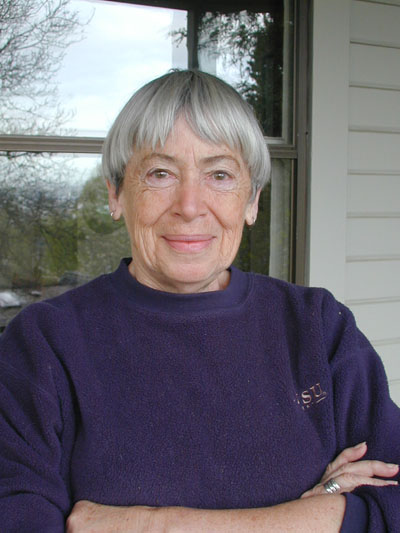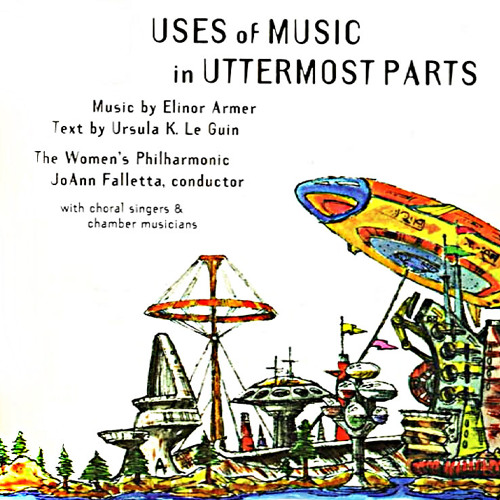

By RL Thornton. Introduction: After discussing Ursula K. Le Guin’s other collaborations with musicians (see the first part of this article), I contacted composer Elinor Armer to discuss her collaborations with Le Guin on their work Uses of Music in Uttermost Parts on Koch Classical and Armer’s settings of Le Guin’s poems in From To The Western Sea – Remembering Ursula K. Le Guin on Centaur.


Here are my questions:
1. How did you and Ursula K. Le Guin first meet and when did you decide to work together on compositions?
2. How did both of you come up with a compositional style for Uses For Music In Uttermost Parts? It feels very modernist to me.
3. Once you started to work together, what sorts of ideas did you come up with? Did you discard any concepts before settling on Uttermost Parts?
4. What was it like spending nine years to finish the composition? When did it become evident that it would take that much time?
ELINOR ARMER: During the early 80’s Ursula Le Guin’s daughter Elisabeth was a student in the first counterpoint class I taught at the San Francisco Conservatory. Elisabeth and I remained friends after her graduation, and it was in the mid-80’s that I met Ursula at Elisabeth’s wedding. Ursula had grown up next door to my grandparents’ house in Berkeley, my grandmother and her mother had been friends, so we had reason to know OF each other but didn’t actually meet until Elisabeth’s wedding.
Ursula and I had never sought each other out, as strangers, asking about collaboration; however, when we met I asked her (naively) if she wrote poetry and had any that might be set to music. She subsequently sent me a few volumes and also loose-leaf, individual poems. From these sources I selected five which seemed to me to form a cycle and then began setting them the following summer while at the MacDowell Colony. The title, “Lockerbones/Airbones”, referred to one of the five poems containing these Ursula-contrived words. The set was performed in San Francisco the following year and subsequently published by my first publisher, J. B. Elkus & Son. Some years later we recorded another performance and Ursula put it on her website where it remains to this day. (All pertinent details regarding performers, sources, etc., may be found there.)
So you see, it was friendship first, then my setting of already written poems—not a collaboration in the true sense at first. That friendship flourished and gave us great fun and pleasure; when we did decide to collaborate on something together from the ground up, I learned the true meaning of art as play, deep play. (We laughed uproariously at times, when Beethoven would have scowled.) On one of my visits to her California vacation home we agreed that it would be fun to collaborate on something from scratch. We came up with the preposterous notion of music being used for other purposes. We did not, however, conceive of the whole series or what it would become or what it would be called, nor did we work non-stop for ten years on this theme. Rather, when I received, sporadically, future commissions or requests from various performing forces I would consult with her to see if she thought we might collaborate in these instances. The musical forces involved on each occasion suggested the appropriate simile; for example, when I told her I had received a grant to compose something for the San Francisco Girls Chorus, she then created the text for Anithaca, designed for girls’ voices, a capella.
Ursula did not come up with “compositional styles”, nor I with textual ones. Fundamentally, I do not have a single compositional “style” that can be defined as such. Rather, I looked for characteristics in each of Ursula’s texts that could also translate to musical qualities. For example, both food and music can be crunchy, sweet, bitter, rich, liquid, thick, thin, spicy, etc; both music and weaving have threads, patterns, texture, direction (warp and weft), etc., etc.
So you see, while it was ten years or so before we recorded “Uses of Music in Uttermost Parts”, we did not start out with this as a goal. Rather, most of the pieces came about when opportunities arose as described above. It was not until after Ursula and I had co-narrated “The Great Instument of the Geggerets” with the Women’s Philharmonic under JoAnn Falletta’s baton, that we decided to form a series under one title.
Discover more from File 770
Subscribe to get the latest posts to your email.

I have missed an awful lot of things over the years. In this text I discover that I missed Ursula working the JoAnn Falletta, two of the women I most admire.